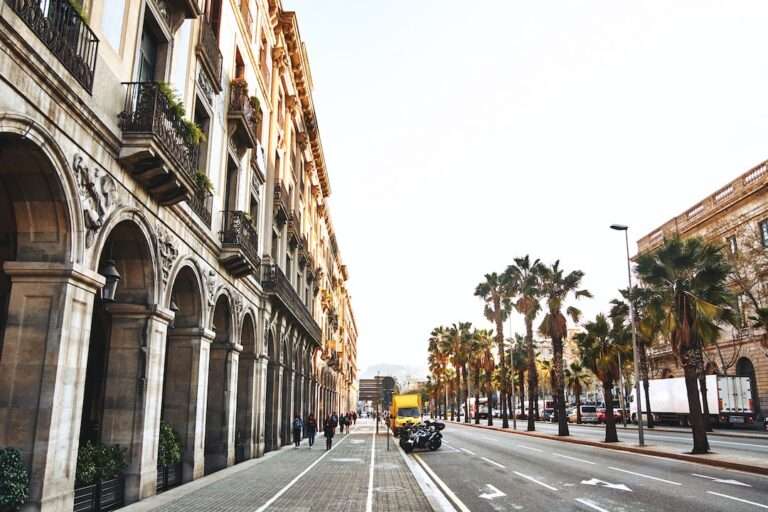10+ Foodie Destinations in Europe
For foodies, Europe is a dream destination. Home to a variety of cultures, cuisines, and culinary traditions, Europe offers something for everyone to enjoy. Whether you’re a fan of high-end fine dining, street food, farm-to-table experiences, or classic comfort dishes, Europe has something for you.
In this article, we’ll take you on a gastronomic journey through the best foodie destinations in Europe. We’ll share must-try dishes in each city, as well as tips for making the most out of your visit.
Whether you’re a seasoned foodie or just looking to explore some amazing cuisine, these destinations are sure to delight your taste buds and leave you craving more. So, pack your bags and get ready to indulge in some of the best food Europe has to offer!
Best foodie destinations in Europe
Rome, Italy
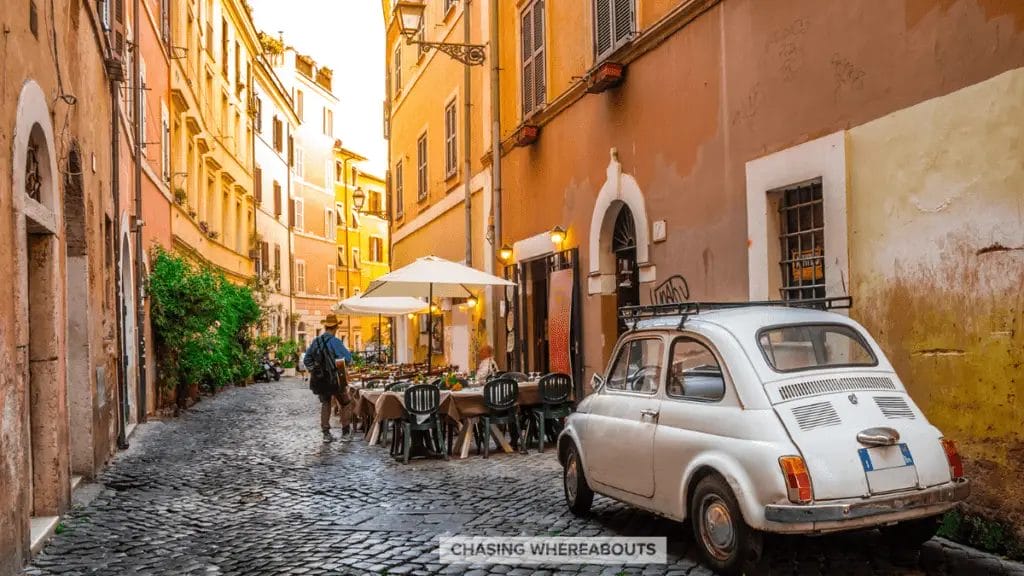
Rome is a city that is synonymous with food. It is impossible to go hungry in the Italian capital, with its wide range of delicious dishes and tempting aromas wafting through the streets. Classic Roman dishes include carbonara and amatriciana pasta, thin-crust Roman-style pizza, and gelato. These dishes are not only mouthwatering but also deeply rooted in the city’s history and culture. For a truly authentic experience, head to local markets and family-run trattorias for a taste of the real Rome.
Must-try food in Rome
- Pizza al taglio – Rome is known for its delicious pizza, and pizza al taglio (or pizza by the slice) is a popular option for a quick and affordable meal. The rectangular slices are sold by weight and can be topped with a variety of ingredients, such as mozzarella, tomato sauce, vegetables, and cured meats.
- Carbonara – This classic Roman pasta dish features spaghetti tossed with a sauce made from eggs, cheese, black pepper, and guanciale (cured pork cheek). The result is a creamy, indulgent pasta dish that is a favorite among locals and tourists alike.
- Cacio e pepe – Another classic Roman pasta dish, cacio e pepe features spaghetti or another long pasta tossed with a sauce made from Pecorino Romano cheese and black pepper. Simple but flavorful, this dish is a must-try for any pasta lover.
- Supplì – Similar to arancini from southern Italy, supplì are small rice balls that are filled with tomato sauce, mozzarella, and sometimes ground meat. They are breaded and fried, resulting in a crispy exterior and a gooey, cheesy interior.
- Gelato – No visit to Rome is complete without indulging in some gelato. This Italian version of ice cream comes in a variety of flavors, from classic options like vanilla and chocolate to more unique flavors like fig and ricotta.
Rome’s culinary scene is a celebration of fresh, simple ingredients and traditional cooking techniques. Make sure to explore the city’s many restaurants and cafes to fully immerse yourself in the delicious flavors of Italy.
Tips for Visiting Rome on Food Tourism
- Try the traditional Roman dishes: Rome is known for its classic dishes like cacio e pepe, carbonara, and amatriciana. Don’t leave without trying these iconic dishes in their authentic form.
- Explore the markets: Rome has many markets, including Campo de’ Fiori and Mercato Centrale, where you can find fresh produce, meats, cheeses, and more. Take a stroll through the markets to experience the local food culture.
- Visit the Trastevere neighborhood: This charming area is known for its narrow streets and traditional Roman trattorias. It’s a great place to try some local specialties, such as fried artichokes or tripe.
- Go on a food tour: A food tour is a great way to taste a variety of local dishes and learn about the city’s culinary history. There are many options available, including walking tours and bike tours.
- Make reservations: Some of Rome’s most popular restaurants can fill up quickly, so it’s a good idea to make reservations in advance, especially for dinner.
- Try the street food: Rome has some delicious street food options, including supplì (deep-fried rice balls with cheese), pizza al taglio (pizza by the slice), and porchetta (roast pork). Don’t be afraid to try these tasty snacks on the go.
- Save room for dessert: Rome is known for its sweet treats, including gelato, tiramisu, and cannoli. Be sure to leave some room for dessert after your meal.
With these tips in mind, you’re sure to have a delicious and memorable foodie experience in Rome.
Read More: Things to do in Rome
Athens, Greece
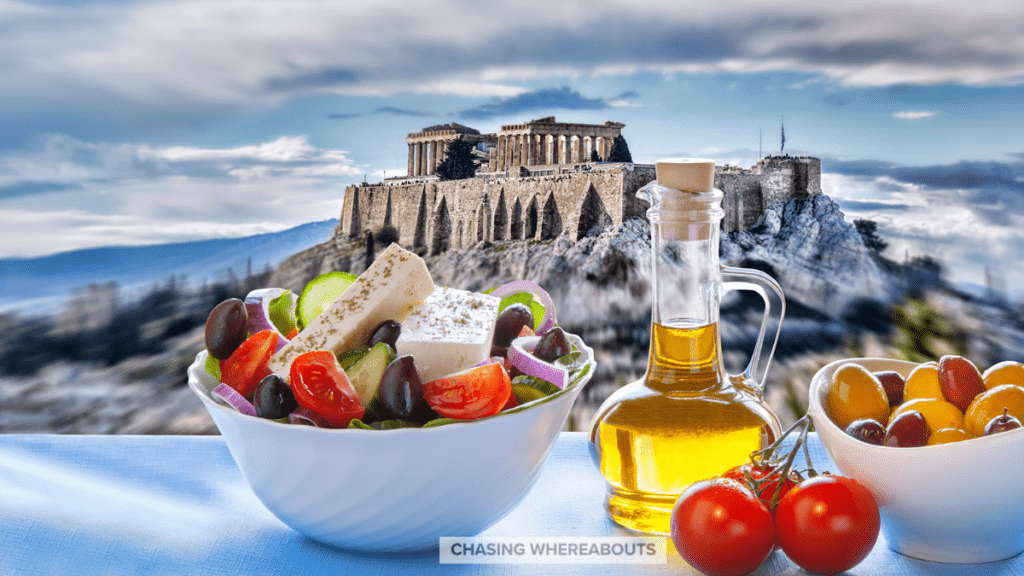
Greek cuisine is both flavorful and healthy, and Athens is a great place to experience it. Greek dishes often feature fresh herbs, olive oil, and a variety of seafood and vegetables. Must-try dishes include moussaka (layers of eggplant, tomato, and ground meat topped with a creamy bechamel sauce), gyros (meat cooked on a vertical rotisserie and served in a pita with vegetables and tzatziki sauce), spanakopita (spinach and feta cheese baked in phyllo dough), and the famous Greek salad (tomatoes, cucumbers, onions, feta cheese, and olives dressed with olive oil and lemon juice). For dessert, try baklava (a sweet pastry made with layers of phyllo dough, nuts, and honey syrup) or loukoumades (Greek-style donuts).
Must-try food in Athens, Greece
- Souvlaki – A popular street food in Greece, souvlaki consists of small pieces of grilled meat (usually pork, chicken, or lamb) served on a skewer or in a pita bread with tomato, onion, and tzatziki sauce. It’s a delicious and filling meal that is perfect for a quick lunch or dinner.
- Moussaka – This classic Greek dish is a hearty casserole made with layers of sliced eggplant, ground meat (usually beef or lamb), and a creamy béchamel sauce. It’s a comforting and flavorful meal that is perfect for cooler evenings.
- Greek Salad – Made with fresh tomatoes, cucumbers, onions, olives, and feta cheese, Greek salad is a refreshing and healthy dish that is perfect for hot summer days. It’s typically dressed with olive oil and a sprinkle of dried oregano.
- Spanakopita – This savory pastry is made with phyllo dough and filled with spinach, feta cheese, and herbs. It’s baked until crispy and golden brown, resulting in a delicious and satisfying snack or appetizer.
- Baklava – A sweet pastry made with layers of phyllo dough, chopped nuts, and honey syrup, baklava is a popular dessert in Greece. It’s typically cut into small diamond-shaped pieces and enjoyed with a cup of coffee or tea.
Athens’ culinary scene is a celebration of fresh ingredients and traditional Greek flavors. Make sure to explore the city’s many tavernas and restaurants to fully immerse yourself in the delicious cuisine of Greece.
Tips for Visiting Athens, Greece on Food Tourism
- Try the traditional Greek dishes: Athens is home to some of the most delicious traditional Greek dishes. Some of the must-try dishes include moussaka, souvlaki, tzatziki, dolmades, and spanakopita.
- Visit the central market: The central market in Athens is a foodie’s paradise. You’ll find a wide range of fresh produce, seafood, spices, and meats. You can also find small restaurants and food stalls where you can try some of the local specialties.
- Explore the neighborhoods: Athens has a lot of neighborhoods with their own unique food scenes. Plaka is known for its traditional Greek taverns, Psirri for its contemporary Greek cuisine, and Kolonaki for its high-end restaurants.
- Take a food tour: Taking a food tour is a great way to sample a variety of Greek dishes while learning about the history and culture of Athens. You can choose from walking tours, bike tours, or even cooking classes.
- Visit a winery: Greece is known for its wines, so a visit to a winery is a must. There are many wineries around Athens, some of which offer tastings and tours.
- Attend a food festival: Athens hosts several food festivals throughout the year, such as the Athens Street Food Festival and the Greek Food Festival. These festivals are a great opportunity to sample a wide range of Greek dishes in one place.
- Try the street food: Athens is famous for its street food, and you’ll find vendors selling everything from souvlaki and gyros to loukoumades (Greek doughnuts) and koulouri (sesame-covered bread rings). Don’t be afraid to try something new!
Read More: Things to do in Athens
Paris, France
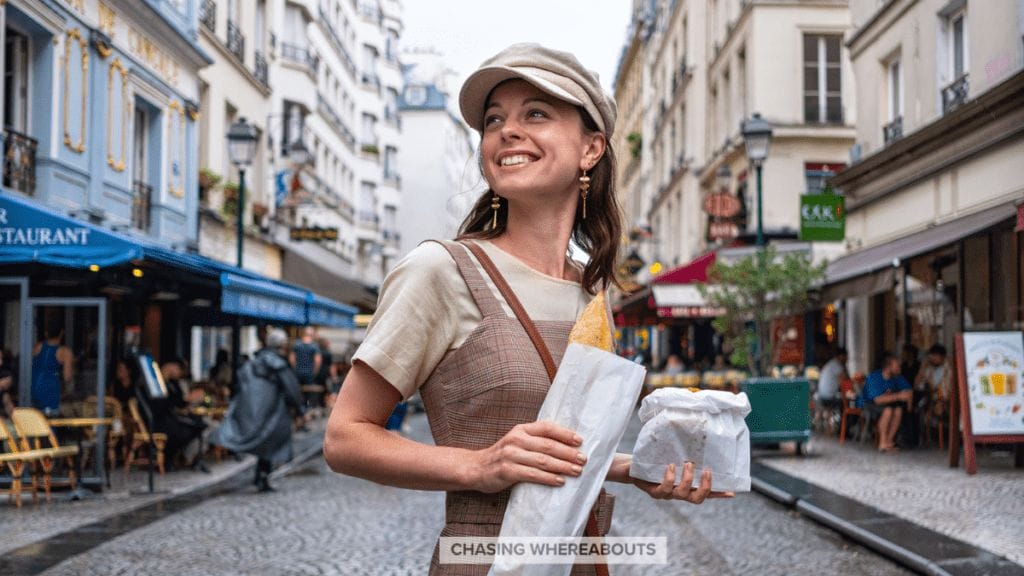
Paris is known for its sophisticated and elegant cuisine, with a focus on rich, buttery flavors and high-quality ingredients. Famous dishes include croissants and baguettes, escargots (snails cooked in garlic butter), coq au vin (chicken cooked in red wine), and bouillabaisse (fish stew). Of course, no trip to Paris is complete without indulging in some wine and cheese. Visit local markets and patisseries to experience the best of Parisian cuisine.
Must-try food in Paris, France
- Croissants – This classic French pastry is a breakfast staple in Paris. Made with layers of buttery, flaky dough, croissants are best enjoyed fresh from the bakery with a cup of coffee or hot chocolate.
- Steak frites – A simple but delicious dish, steak frites features a grilled steak served with a side of crispy french fries. It’s a popular meal in Parisian brasseries and bistros.
- Escargots – If you’re feeling adventurous, try the classic French dish of escargots, or snails. Cooked with garlic butter and herbs, escargots have a tender, chewy texture and a rich, savory flavor.
- Coq au vin – This hearty, rustic dish features chicken cooked in red wine with bacon, onions, and mushrooms. It’s a comforting and flavorful meal that is perfect for colder months.
- Crème brûlée – This classic French dessert consists of a rich, creamy custard that is topped with a layer of caramelized sugar. It’s a decadent and indulgent treat that is perfect for ending a meal.
Paris’ culinary scene is a celebration of classic French cuisine and modern innovation. Make sure to explore the city’s many bakeries, bistros, and Michelin-starred restaurants to fully immerse yourself in the delicious flavors of France.
Tips for Visiting Paris, France on Food Tourism
- Explore Local Markets: Paris is home to some of the most vibrant food markets in the world. Make sure to visit Marché d’Aligre, Marché des Enfants Rouges, and Marché Raspail, among others. Here, you’ll find fresh produce, cheeses, meats, and baked goods, as well as street food vendors serving up everything from crepes to falafel.
- Try Classic French Dishes: No trip to Paris is complete without trying some of the city’s classic French dishes. From escargot to coq au vin, steak frites to bouillabaisse, there’s no shortage of iconic dishes to indulge in. Be sure to make reservations at some of the city’s top restaurants, such as L’Ambroisie and Le Jules Verne.
- Sample International Cuisine: Paris is a melting pot of cultures, and this is reflected in its diverse culinary scene. Whether you’re in the mood for sushi, dim sum, or tacos, you’ll find plenty of options to satisfy your cravings. Check out neighborhoods like the 13th arrondissement and Belleville for some of the best international food in the city.
- Visit Patisseries and Bakeries: Paris is famous for its patisseries and bakeries, and for good reason. From flaky croissants to buttery madeleines, Parisian pastries are a treat for the senses. Don’t miss out on visiting patisseries like Pierre Hermé and Ladurée, as well as boulangeries like Du Pain et des Idées and Poilâne.
- Take a Food Tour: To get a true taste of Paris, consider taking a food tour. There are plenty of options to choose from, including walking tours, bike tours, and even boat tours. You’ll get to try a variety of dishes, learn about the city’s culinary history, and get insider tips on where to eat and drink.
By following these tips, you’ll be sure to have an unforgettable foodie experience in Paris. Bon appétit!
Read More: Things to do in Paris
Porto, Portugal
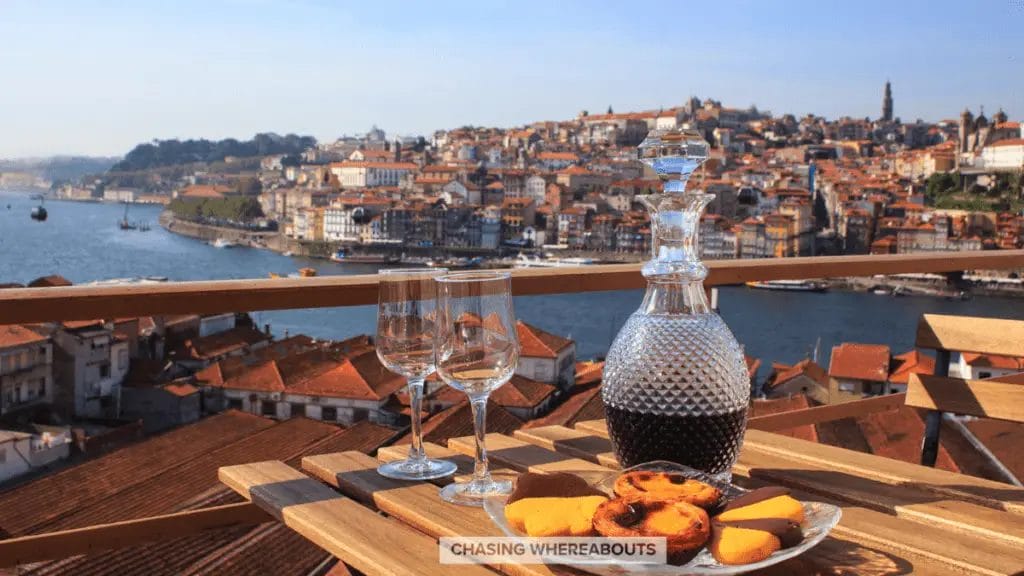
Porto is known for its seafood, wine, and pastries. Located on the Douro River, Porto has a rich culinary heritage that is influenced by the sea, the land, and the vineyards. Must-try dishes include bacalhau (salt cod, a staple of Portuguese cuisine), francesinha (a meat sandwich with cheese and a spicy sauce), and pastel de nata (custard tart). Wash it all down with some port wine from the nearby Douro Valley, which is considered to be one of the best wine regions in the world.
Must-try food in Porto, Portugal
- Francesinha – This hearty sandwich is a specialty of Porto, featuring layers of cured ham, linguiça sausage, steak, and melted cheese. It’s served in a tomato and beer sauce and topped with a fried egg. It’s a filling and flavorful meal that is perfect for lunch or dinner.
- Bacalhau – A staple of Portuguese cuisine, bacalhau is a dish made with salted cod that has been soaked and cooked with onions, garlic, and potatoes. There are many different variations of bacalhau, each with its own unique seasoning and preparation method.
- Caldo verde – This traditional soup is made with potatoes, kale, and chorizo sausage. It’s a comforting and nourishing dish that is perfect for cooler weather.
- Pastéis de nata – These small custard tarts are a beloved dessert in Portugal, and the best can be found in Porto’s historic pastry shops. The tarts are made with a flaky, buttery pastry and a rich, creamy custard filling.
- Tripas à moda do Porto – This hearty stew features tripe cooked with white beans, chorizo sausage, and a variety of meats. It’s a traditional dish that dates back to Porto’s medieval past and is often served during festivals and celebrations.
Porto’s culinary scene is a celebration of traditional Portuguese flavors and ingredients. Make sure to explore the city’s many cafes, tavernas, and seafood restaurants to fully immerse yourself in the delicious cuisine of Portugal.
Tips for Visiting Porto, Portugal on Food Tourism
- Explore the Local Markets: A great way to discover Porto’s food scene is by visiting the local markets. Mercado do Bolhão, one of the oldest markets in the city, is a great place to start. Here, you can find fresh produce, seafood, meats, and cheeses, as well as traditional Portuguese dishes like cozido and tripeiros stew.
- Taste the Port Wine: Porto is famous for its Port wine, so make sure you try some during your visit. Take a trip to Vila Nova de Gaia, where you can visit the wine cellars and taste the different varieties of Port wine.
- Try the Seafood: With its location on the Atlantic coast, Porto is known for its fresh seafood. From grilled sardines to octopus, there are plenty of delicious seafood dishes to try in Porto.
- Sample the Francesinha: The Francesinha is a sandwich that’s unique to Porto. It’s made with bread, ham, sausage, and beef, and is topped with melted cheese and a spicy tomato sauce. It’s a filling and hearty dish that’s perfect for a lunchtime treat.
- Visit Traditional Tascas: Tascas are traditional Portuguese restaurants that serve homestyle cooking. They’re often small and cozy, with a family-like atmosphere. Look out for tasca signs around the city and try some of the local dishes.
- Try the Pastries: Portugal is famous for its pastries, and Porto is no exception. The most famous is the Pastel de Nata, a delicious custard tart. You can also try other pastries like the Bola de Berlim or the Jesuíta.
- Take a Food Tour: To make the most of your food tourism experience, consider taking a food tour. There are several companies that offer food tours in Porto, where you can taste the best of the city’s cuisine while learning about its history and culture.
Read More: Things to do in Porto
Madrid, Spain

The food scene in Madrid is all about tapas, small plates of food that are perfect for sharing with friends while enjoying some wine. Must-try dishes include patatas bravas (spicy potatoes), croquetas (deep-fried bites filled with cheese, ham, or seafood), and tortilla española (a potato and onion omelette). Other popular dishes include churros con chocolate (fried dough dipped in hot chocolate), jamón ibérico (cured ham from acorn-fed pigs), and paella (a rice dish with seafood, chicken, or vegetables). Madrid is also famous for its nightlife, so be sure to check out some of the city’s bars and clubs.
Must-try food in Madrid, Spain
- Huevos rotos – This popular breakfast dish consists of fried eggs served over a bed of crispy fried potatoes, known as “patatas bravas.” It’s a simple but delicious way to start the day.
- Cocido madrileño – This hearty stew features chickpeas, meats, and vegetables, and is a staple of traditional Madrid cuisine. It’s a comforting and filling dish that is perfect for cooler weather.
- Bocadillo de calamares – This sandwich features crispy fried calamari served on a crusty baguette with a squeeze of lemon juice. It’s a popular snack or light lunch option in Madrid.
- Churros con chocolate – A classic Spanish dessert, churros are crispy fried dough pastries that are served with a thick, rich chocolate dipping sauce. They’re a popular snack or after-dinner treat in Madrid.
- Tortilla española – This thick, fluffy omelet is a staple of Spanish cuisine, and in Madrid, it’s often served as a tapa or small appetizer. Made with eggs, potatoes, onions, and sometimes other ingredients like chorizo or peppers, it’s a simple but flavorful dish.
Madrid’s culinary scene is a blend of traditional Spanish flavors and modern innovation. Make sure to explore the city’s many tapas bars, restaurants, and food markets to fully immerse yourself in the delicious cuisine of Spain.
Tips for Visiting Madrid, Spain on Food Tourism
- Try the Tapas: Madrid is famous for its tapas, which are small dishes of appetizers that are often shared amongst friends over drinks. Look for bars and restaurants that have a good selection of tapas and try a variety of them to experience the range of flavors Madrid has to offer.
- Visit the Mercado de San Miguel: This historic market is a must-visit for foodies. You’ll find everything from fresh seafood to artisan cheeses and cured meats. This is a great place to pick up some snacks to enjoy throughout the day or to find ingredients for a picnic.
- Sip on Vermouth: Vermouth is a fortified wine that is often served as an aperitif in Madrid. It’s usually served with a twist of lemon or a few olives. It’s a great way to start your meal and to get a taste of the local culture.
- Try Cocido Madrileño: This hearty stew is a traditional dish in Madrid, typically made with chickpeas, vegetables, and meat. It’s often served in three courses, with the broth, then the vegetables and chickpeas, and finally the meat. It’s a filling and delicious meal that will keep you warm on a cold day.
- Visit a Churrería: Churros are a popular sweet snack in Madrid, often enjoyed for breakfast or as a mid-afternoon treat. They are typically served with a cup of hot chocolate for dipping. Look for a churrería that makes their churros fresh to order for the best experience.
- Take a Food Tour: If you’re not sure where to start, consider taking a food tour. You’ll be able to try a variety of dishes and learn about the history and culture behind them. It’s a great way to get a crash course in Madrid’s food scene and discover some hidden gems.
- Enjoy a Paella: Although paella is a dish that is more associated with Valencia than Madrid, it’s still widely enjoyed in the city. Look for a restaurant that specializes in paella and enjoy a big, steaming plate of this delicious rice dish.
Read More: Things to do in Madrid
Amsterdam, Netherlands
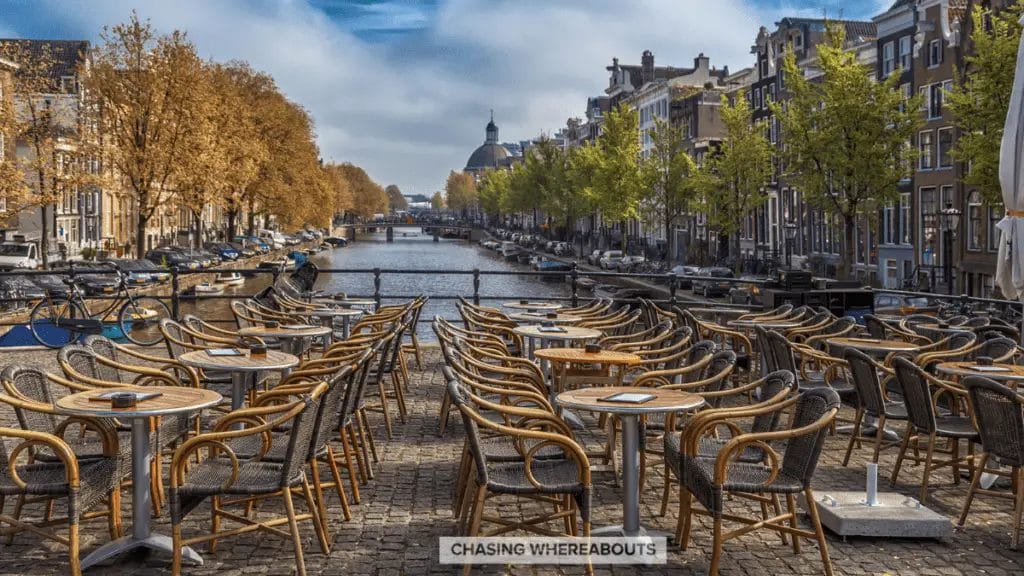
Amsterdam is known for more than just its coffee shops. The Dutch cuisine is hearty and comforting, with dishes like stamppot (mashed potatoes with vegetables and sausage), bitterballen (deep-fried meatballs filled with beef ragout), and poffertjes (small pancakes served with butter and powdered sugar). Don’t forget to try some Dutch cheese, which is renowned for its rich flavor and creamy texture.
Must-try food in Amsterdam, Netherlands
- Stroopwafels – These sweet, syrupy waffles are a classic Dutch treat. They consist of two thin waffles sandwiched together with a layer of caramel-like syrup in the middle. You can find them at street markets and bakeries all over Amsterdam.
- Bitterballen – These small, deep-fried snacks are a popular bar snack in the Netherlands. They are typically made with a mixture of beef or veal ragout and breadcrumbs, and are served hot with mustard for dipping.
- Poffertjes – These small, fluffy pancakes are a beloved Dutch treat, typically served with butter and powdered sugar. They’re a great option for a sweet breakfast or a mid-day snack.
- Raw herring – If you’re feeling adventurous, try this traditional Dutch snack. Raw herring is typically served with chopped onions and pickles, and can be found at herring carts around Amsterdam.
- Indonesian rijsttafel – Although not traditionally Dutch, this Indonesian-inspired feast has become a popular part of Amsterdam’s culinary scene. Rijsttafel consists of a variety of small, flavorful dishes served with rice, and is a great way to sample a range of Indonesian flavors.
Amsterdam’s food scene is diverse and exciting, with influences from all over the world. Make sure to explore the city’s markets, cafes, and restaurants to discover all the delicious flavors that Amsterdam has to offer.
Tips for Visiting Amsterdam, Netherlands on Food Tourism
- Try local specialties: Amsterdam has some delicious local dishes that you won’t want to miss. Be sure to try stroopwafels, a thin waffle cookie filled with syrup, and bitterballen, a deep-fried meatball snack.
- Visit local markets: Amsterdam is home to several bustling markets, including the famous Albert Cuyp Market and the Noordermarkt. These markets are the perfect place to sample local foods and shop for ingredients to take home with you.
- Take a food tour: A food tour is a great way to discover the best of Amsterdam’s food scene. You can choose from a variety of tours that focus on different types of cuisine or neighborhoods, and you’ll get to taste a range of delicious dishes along the way.
- Visit the Jordaan neighborhood: This charming neighborhood is known for its cozy cafes, trendy restaurants, and delicious street food. Be sure to try some Dutch herring or a kroket from one of the local vendors.
- Explore Amsterdam’s multicultural food scene: Amsterdam is a diverse city with a thriving multicultural food scene. Don’t miss the chance to try some Indonesian rijsttafel or Surinamese roti while you’re in town.
- Visit a brewery: Amsterdam is home to several great breweries, including the famous Heineken brewery. Take a tour to learn about the brewing process and sample some local beers.
- Take a cooking class: If you want to learn how to cook some of Amsterdam’s local dishes, sign up for a cooking class. You’ll get hands-on experience preparing traditional Dutch foods like stamppot or pea soup.
By following these tips, you’re sure to have an unforgettable food tourism experience in Amsterdam.
Read More: Things to do in Amsterdam
Lyon France

Lyon is considered by many to be the gastronomic capital of France, with a long history of culinary excellence. The city is famous for its bouchons, traditional Lyonnaise restaurants that serve hearty, rustic dishes like coq au vin, pâté en croûte, and quenelles (a type of dumpling made with fish). Lyon is also home to a number of Michelin-starred restaurants, offering innovative and modern takes on classic French cuisine. To experience the best of Lyon’s food scene, head to the markets and sample local cheeses, sausages, and wines.
Must-try food in Lyon France
- Coq au vin – This classic French dish is made with chicken, bacon, mushrooms, and red wine, and is typically served with potatoes or rice. Lyon is known for its delicious version of coq au vin, which is made with local ingredients.
- Quenelles – These light and fluffy dumplings are a specialty of Lyon. They are typically made with a mixture of fish, eggs, and breadcrumbs, and are often served in a creamy sauce.
- Cervelle de canut – This is a creamy, tangy cheese spread that is made with fromage blanc, garlic, shallots, herbs, and vinegar. It is often served as a dip for bread or vegetables.
- Tarte aux pralines – This is a classic Lyonnaise dessert that consists of a tart filled with pink praline paste. The praline paste is made by caramelizing almonds with sugar, and gives the tart a beautiful pink color.
- Andouillette – This is a sausage made from tripe and pork intestines, and is a beloved specialty of Lyon. It has a strong, distinctive flavor that is not for everyone, but is a must-try for adventurous eaters.
Lyon’s food scene is rich and diverse, with plenty of traditional dishes to try alongside more modern and creative cuisine. Make sure to visit the city’s many markets, bouchons (traditional Lyonnaise restaurants), and bakeries to discover all the delicious flavors of Lyon.
Tips for Visiting Lyon France on Food Tourism
- Explore the food markets: Lyon is known for its lively and colorful food markets, such as Les Halles de Lyon Paul Bocuse and Marché de la Croix-Rousse. These markets offer a wide variety of fresh produce, cheese, charcuterie, bread, and more. Take a stroll through the markets to experience the local food culture and sample some of the delicious treats.
- Indulge in Lyonnaise cuisine: Lyon is considered the gastronomic capital of France, so it’s a must-visit destination for foodies. Be sure to try some traditional Lyonnaise dishes such as coq au vin, quenelle de brochet (pike quenelle), andouillette (sausage), and the famous Lyonnaise salad.
- Visit a Bouchon: A Bouchon is a traditional Lyonnaise restaurant that serves hearty, homestyle dishes. They are known for their friendly and relaxed atmosphere, and offer a unique dining experience. Try some of the local wines and indulge in the hearty, rich dishes.
- Take a food tour: To get a more in-depth understanding of Lyon’s food culture, consider taking a food tour. A local guide can show you the best spots to eat and give you insight into the history and culture behind the food.
- Visit a local brewery: Lyon is home to many local breweries that offer a variety of craft beers. Visit one of these breweries to sample some of the local brews and learn about the brewing process.
- Attend a food festival: Lyon hosts many food festivals throughout the year, such as the Fête des Lumières, Les Nuits Sonores, and Les Nuits de Fourvière. These festivals offer a unique opportunity to experience the local food culture and try different dishes from around the region.
Read More: Things to do in Lyon
Barcelona, Spain
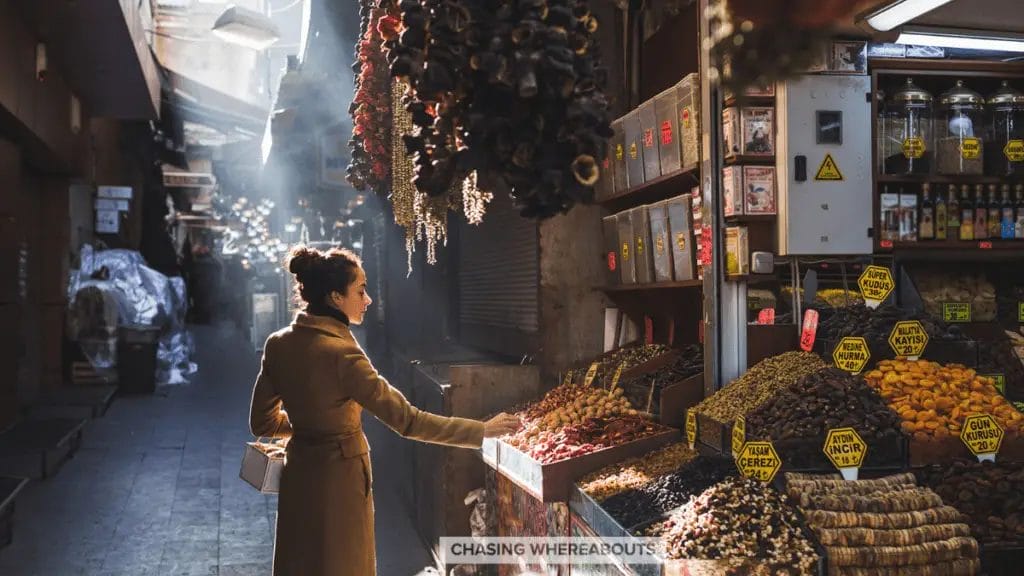
Oh, Barcelona! This vibrant city stole my heart with its lively atmosphere and delicious food. I spent my days wandering the colorful streets and soaking up the unique blend of Catalan and Spanish culture. One of the highlights of my trip was visiting La Boqueria market, where I indulged in the freshest seafood, paella, and tapas. And let’s not forget the churros and crema catalana! If you’re looking for a lively and exciting destination with amazing food, Barcelona is the place to be.
Must-try food in Barcelona, Spain
- Paella – This classic Spanish dish is a must-try when in Barcelona. Made with rice, saffron, and a variety of seafood or meat, paella is a hearty and flavorful meal that is perfect for sharing with friends and family.
- Tapas – Barcelona is known for its tapas culture, with small plates of delicious snacks and appetizers served in every bar and restaurant. Some popular tapas dishes include patatas bravas (fried potatoes with a spicy tomato sauce), croquettes (deep-fried balls of bechamel sauce and filling), and jamón ibérico (cured ham).
- Seafood – Being a coastal city, Barcelona is famous for its seafood. Some must-try dishes include fideuà (similar to paella, but made with noodles instead of rice and seafood), grilled or fried squid, and esqueixada (a salad made with salt cod, tomatoes, onions, and olives).
- Cava – Spain’s answer to Champagne, cava is a sparkling wine that is produced in the Catalonia region. Whether you’re celebrating a special occasion or just looking to unwind after a long day of sightseeing, a glass of cava is the perfect way to toast to your Barcelona adventure.
- Crema Catalana – This Catalan version of crème brûlée is a dessert that is not to be missed. Made with a custard base flavored with cinnamon and lemon, and topped with a layer of caramelized sugar, it’s a sweet and creamy treat that will satisfy any sweet tooth.
Overall, Barcelona is a foodie’s paradise with a diverse and delicious culinary scene. Make sure to explore the city’s many restaurants and bars to fully immerse yourself in the flavors of this vibrant city.
Tips for Visiting Barcelona, Spain on Food Tourism
Barcelona is a foodie’s paradise, with a rich culinary culture that combines traditional Spanish and Catalan flavors with modern innovations. Here are some tips for visiting Barcelona and exploring its delicious food scene:
- Try traditional Spanish and Catalan cuisine – Barcelona is known for its classic Spanish dishes like paella, tapas, and jamón ibérico. Don’t miss the opportunity to try local Catalan dishes like escalivada (roasted vegetables), botifarra (Catalan sausage), and fideuà (a seafood and noodle dish similar to paella).
- Visit the food markets – Barcelona is home to several bustling food markets, including the famous La Boqueria market on La Rambla. These markets are a great way to sample fresh produce, meats, cheeses, and other local specialties.
- Take a food tour – Barcelona has many excellent food tours available, ranging from casual tapas crawls to more in-depth tours that explore specific neighborhoods or food themes. These tours are a fun way to learn about the city’s culinary history and discover new flavors.
- Explore the neighborhood of El Born – This trendy neighborhood is home to many of Barcelona’s best restaurants and bars, as well as artisanal food shops and bakeries. Try the vermouth at the historic Bormuth bar, or sample artisanal cheeses and meats at Formatgeria La Seu.
- Visit a bodega – Barcelona is surrounded by wine-producing regions like Penedès and Priorat, and there are many bodegas and wine bars in the city where you can sample local wines. Try a glass of cava (Spanish sparkling wine) or a bold red from the Priorat region.
- Eat like a local – Barcelona has many small, family-run restaurants and cafes that serve traditional home-cooked dishes. Look for places with menus in Catalan, or ask locals for recommendations. Don’t be afraid to try something new!
- Take advantage of the city’s coffee culture – Barcelona has a thriving coffee scene, with many cafes serving specialty coffees like cortados (espresso with a small amount of steamed milk) and cafe con leche (coffee with milk). Try a cafe amb llet (coffee with condensed milk) at one of the city’s historic cafes like Cafe de l’Òpera.
Overall, Barcelona is a food lover’s dream destination, with something to suit every taste and budget. With a little planning and an adventurous spirit, you’re sure to discover some amazing new flavors in this vibrant city.
Read More: Things to do in Barcelona
Lisbon, Portugal
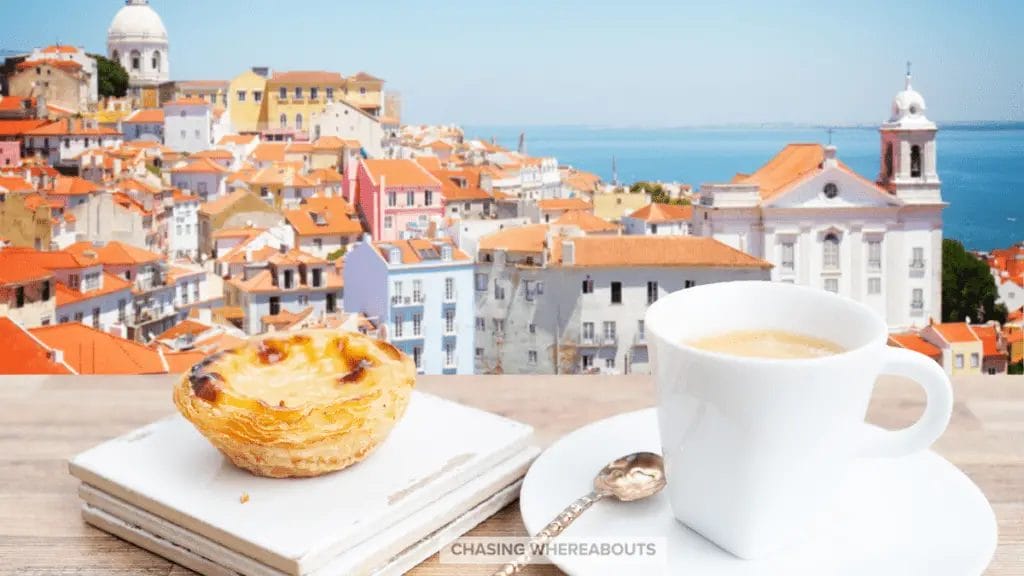
Lisbon is a hidden gem that I stumbled upon during my travels. This city is bursting with charm and character, from its stunning architecture to its colorful streets. And the food? Don’t even get me started. One of the must-try dishes is the pastel de nata, a custard tart that is pure heaven in your mouth. I also fell in love with the grilled sardines, bacalhau, feijoada, and bifanas. And let’s not forget the wine and port! If you’re looking for a city that is rich in history, culture, and delicious food, Lisbon should be at the top of your list.
Must-try food in Lisbon, Portugal
- Pastel de Nata – This iconic Portuguese pastry is a must-try when in Lisbon. A small, creamy custard tart with a crispy pastry crust, pastel de nata is best enjoyed fresh out of the oven with a dusting of cinnamon and powdered sugar.
- Bacalhau – Salt cod is a staple in Portuguese cuisine, and Lisbon is no exception. Whether it’s grilled, fried, or baked, bacalhau can be found on menus all over the city. One classic dish to try is bacalhau com natas, a baked casserole made with layers of potatoes, onions, cream, and shredded salt cod.
- Grilled sardines – Lisbon’s coastal location means that fresh seafood is a must-try. Grilled sardines, in particular, are a classic dish that you’ll find on many menus during the summer months. Served simply with a squeeze of lemon and a sprinkle of salt, they are a delicious and healthy option.
- Cozido – This hearty stew is a comfort food favorite in Lisbon. Made with a variety of meats, sausages, and vegetables, cozido is a one-pot meal that is perfect for cold, rainy days.
- Ginjinha – This traditional cherry liqueur is a popular after-dinner drink in Lisbon. Served in a shot glass and often accompanied by a cherry at the bottom, ginjinha is sweet, tart, and packs a punch.
Lisbon’s culinary scene is a celebration of fresh, flavorful ingredients and traditional cooking techniques. Make sure to explore the city’s many restaurants and cafes to fully immerse yourself in the delicious flavors of Portugal.
Tips for Visiting Lisbon, Portugal on Food Tourism
- Try traditional Portuguese cuisine – Lisbon is known for its delicious seafood dishes, like grilled sardines and bacalhau (salt cod). Other traditional dishes to try include cozido (a meat and vegetable stew), feijoada (a bean stew with pork), and pastel de nata (a custard tart).
- Visit food markets – Lisbon has several great food markets, including the Mercado da Ribeira and the Time Out Market. These markets offer a variety of food stalls and vendors, and are a great way to sample a range of different flavors in one place.
- Take a food tour – There are many food tours available in Lisbon, which can be a fun and educational way to experience the city’s food culture. Some tours focus on specific neighborhoods or foods, while others offer a broader overview of Portuguese cuisine.
- Explore multicultural neighborhoods – Lisbon is a diverse city, with many different cultural influences on its food scene. Head to neighborhoods like Mouraria and Alfama to try foods from around the world, including African, Brazilian, and Indian cuisines.
- Visit traditional cafes and bakeries – Lisbon has a long tradition of coffee and pastry culture, with many historic cafes and bakeries still in operation today. Try a bica (Portuguese espresso) and a pastel de nata at one of these iconic establishments.
- Go wine tasting – Portugal is known for its excellent wines, including port and vinho verde. Visit a wine bar or take a wine tour to sample some of the best wines that Lisbon has to offer.
- Don’t forget about the street food – Lisbon has a thriving street food scene, with vendors selling everything from grilled sardines to bifanas (pork sandwiches) to churros. Look out for food trucks and stalls on the streets, or head to food markets to try some of the best street food in the city.
Overall, Lisbon is a food lover’s dream destination, with something to suit every taste and budget. With a little planning and some adventurous spirit, you’re sure to discover some amazing new flavors in this vibrant city.
Read More: Things to do in Lisbon
London, UK
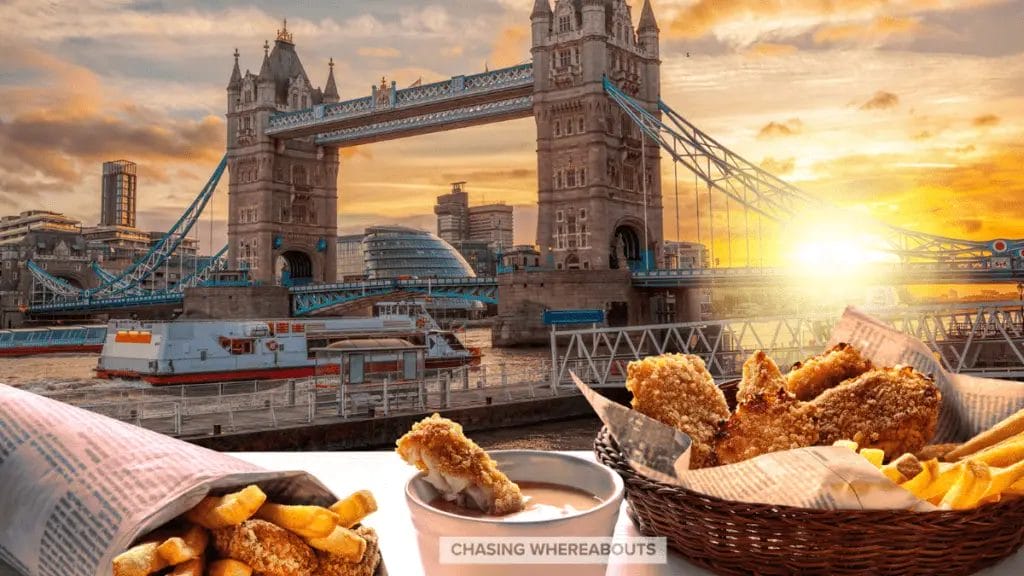
London is a city that needs no introduction. It’s a hub of diversity, culture, and of course, food! I spent my days exploring the city’s iconic landmarks, like Buckingham Palace and the Tower of London, and indulging in the city’s famous dishes. Fish and chips? Check. Roast beef and Yorkshire pudding? Check. Full English breakfast? Check. Afternoon tea? Check. And let’s not forget about the curry, which reflects the city’s historic ties to India. London is a city that has something for everyone, and if you’re a foodie like me, you won’t be disappointed.
Must-try food in London, UK
- Fish and Chips – This classic British dish is a must-try when in London. Made with battered and fried fish (usually cod or haddock) and served with crispy chips (fries), mushy peas, and tartar sauce, fish and chips is a comforting and filling meal that is perfect for a casual lunch or dinner.
- Sunday Roast – Another British classic, Sunday roast is a hearty meal typically enjoyed on Sundays with family and friends. The meal consists of roasted meat (usually beef, lamb, or chicken), roast potatoes, Yorkshire pudding, seasonal vegetables, and gravy.
- Pies – Whether it’s savory meat pies or sweet fruit pies, London is famous for its delicious pies. Some popular options include steak and kidney pie, chicken and mushroom pie, and apple pie.
- Indian food – London is home to a thriving Indian food scene, with some of the best curries and tandoori dishes outside of India. Some must-try dishes include butter chicken, lamb vindaloo, and biryani.
- Afternoon Tea – This quintessentially British experience is a must-try when in London. Typically served in the afternoon, afternoon tea consists of tea, scones with jam and clotted cream, and a selection of sandwiches and pastries.
London’s diverse culinary scene offers something for everyone. From traditional British dishes to international cuisine, the city is a foodie’s paradise. Make sure to explore the many restaurants and markets to fully immerse yourself in the delicious flavors of London.
Tips for Visiting London, UK on Food Tourism
- Visit food markets – London has several fantastic food markets, including Borough Market, Camden Market, and Broadway Market. These markets offer a wide variety of street food, artisanal products, and fresh produce, and are a great way to sample a range of different cuisines in one place.
- Try traditional British cuisine – London is a great place to try classic British dishes like fish and chips, bangers and mash, and shepherd’s pie. For a more upscale experience, try a traditional afternoon tea at a fancy hotel.
- Explore multicultural neighborhoods – London is a diverse city, with a thriving food scene that reflects its many cultures. Head to neighborhoods like Chinatown, Brick Lane, or Little Italy to sample authentic dishes from around the world.
- Visit Michelin-starred restaurants – London is home to many of the world’s top-rated restaurants, and getting a reservation at one of them is a bucket-list experience for foodies. Be prepared to splurge, though, as these restaurants can be quite pricey.
- Take a food tour – There are many guided food tours available in London, which can be a fun and educational way to experience the city’s culinary scene. Some tours focus on specific neighborhoods or cuisines, while others offer a broader overview of London’s food culture.
- Check out food festivals and events – London hosts many food festivals and events throughout the year, including the London Coffee Festival, the London Wine Fair, and the London Craft Beer Festival. These events are a great way to discover new foods and drinks, and to mingle with other foodies.
- Don’t forget about the pubs – London’s pub culture is a big part of its food scene, and many pubs offer classic British dishes as well as a wide selection of beers and ciders. Grab a pint and some pub grub at one of London’s many historic pubs for a truly authentic experience.
Overall, London is a must-visit destination for foodies, with plenty of options for every taste and budget. With a little planning and some adventurous spirit, you’re sure to discover some amazing new flavors in this exciting city.
Read More: Things to do in London
Naples, Italy
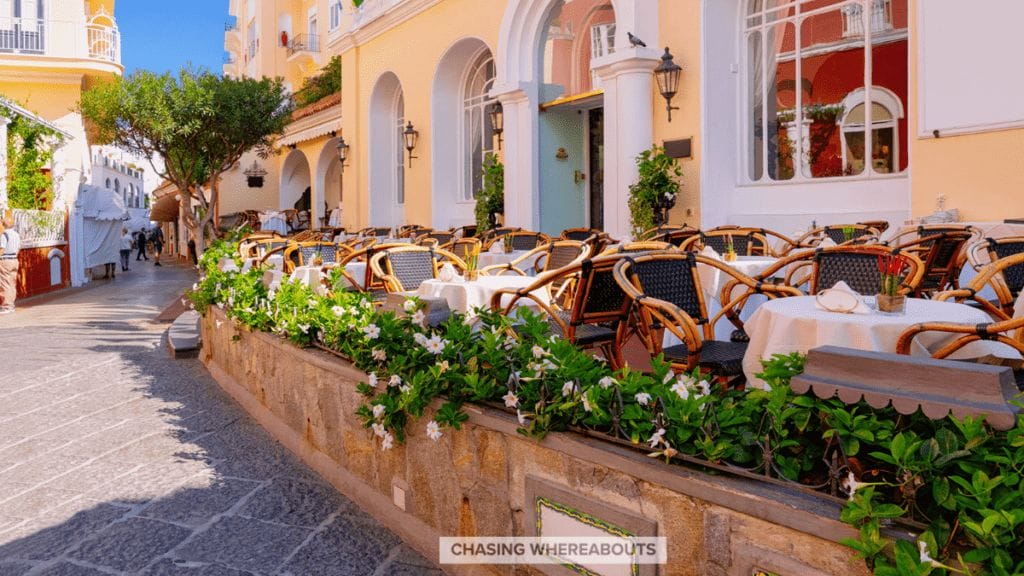
Naples is a vibrant and bustling city located in southern Italy, known for its rich history, stunning architecture, and of course, its delicious cuisine. If you’re a foodie looking to explore the best of Italian cuisine, Naples is definitely worth a visit.
Must-try food in Naples:
- Pizza – Naples is the birthplace of pizza, and you won’t find better pizza anywhere else in the world. The classic Neapolitan pizza is made with San Marzano tomatoes, mozzarella cheese, and fresh basil.
- Pasta – Naples is also known for its delicious pasta dishes, such as spaghetti alle vongole (spaghetti with clams) and linguine alla puttanesca (linguine with tomatoes, olives, and capers).
- Seafood – Being located on the coast, Naples has an abundance of fresh seafood. Some popular dishes include frittura di pesce (mixed fried seafood) and spaghetti alle cozze (spaghetti with mussels).
- Gelato – No trip to Naples is complete without indulging in some gelato. You’ll find plenty of gelato shops throughout the city, offering a wide range of flavors.
Tips for visiting Naples on a food tour:
- Take a pizza-making class – Naples is the best place to learn how to make authentic Neapolitan pizza, so why not take a class and learn from the experts?
- Visit the local markets – Naples has several vibrant markets, such as the Mercato di Porta Nolana and the Mercato di Pignasecca, where you can find fresh produce, meats, and seafood.
- Try street food – Naples is famous for its street food, such as arancini (deep-fried rice balls) and sfogliatelle (a pastry filled with ricotta cheese and candied fruit).
- Sample the local wine – Naples is surrounded by beautiful vineyards, so be sure to sample some of the local wines, such as Aglianico and Falanghina.
- Take a food tour – There are plenty of food tours available in Naples, which will take you to some of the best restaurants, markets, and food stalls in the city.
Read More: Things to do in Naples
Vienna, Austria
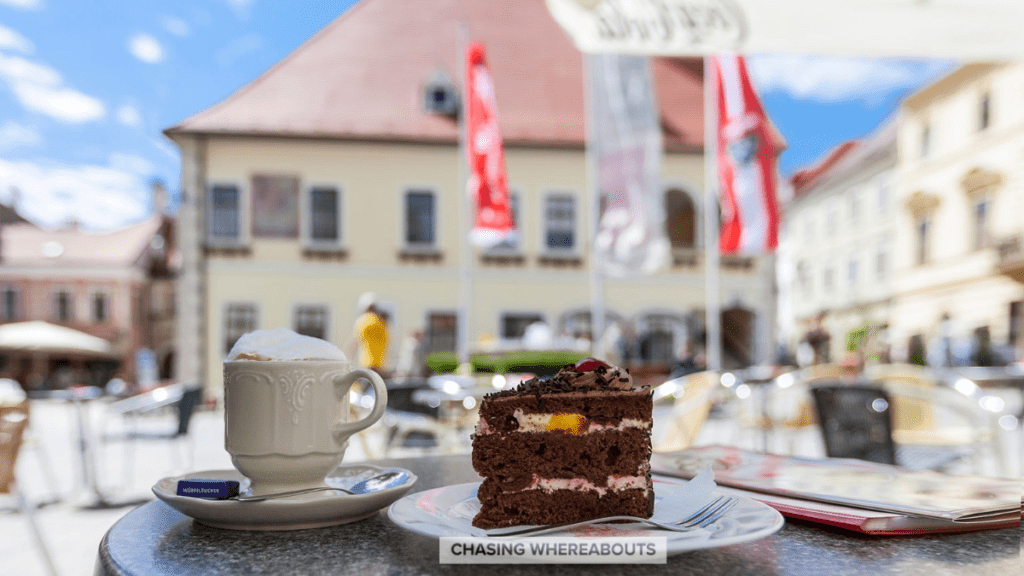
Vienna, the capital city of Austria, is renowned for its rich history, stunning architecture, and thriving food scene. The city’s culinary offerings reflect its imperial heritage and cultural diversity, making it a must-visit destination for foodies.
Must-try food in Vienna:
- Wiener Schnitzel: A traditional Austrian dish consisting of a thin, breaded and pan-fried veal escalope. It is typically served with potatoes, cucumber salad or lingonberry jam.
- Tafelspitz: A classic Viennese dish made from boiled beef, served with horseradish sauce, potatoes and vegetables.
- Sachertorte: A famous Viennese dessert, a chocolate cake with a thin layer of apricot jam, covered in chocolate icing.
- Kaiserschmarrn: A sweet dish of chopped up pancakes served with fruit compote or apple sauce.
- Apfelstrudel: A classic Viennese pastry, a sweet, flaky pastry filled with spiced apples and raisins.
Tips for visiting Vienna on a food tour:
- Visit the Naschmarkt: Vienna’s largest outdoor market, home to a variety of food stalls selling everything from fresh fruits and vegetables to international cuisine.
- Take a culinary walking tour: Explore Vienna’s food scene with a local guide and taste some of the city’s best dishes and wines.
- Attend a wine tasting: Vienna is renowned for its wine, so be sure to visit one of the many wine bars or attend a wine tasting event to sample some of the local varietals.
- Try a traditional coffee house: Vienna is famous for its coffee houses, which are often as much about the ambiance as they are about the coffee. Try a traditional café and enjoy a cup of coffee along with a slice of Sachertorte.
- Visit a Heuriger: A Heuriger is a traditional Austrian wine tavern where locals go to drink young wine and eat hearty, homemade food. Visit one to experience a true taste of Vienna’s culinary traditions.
Read More: Things to do in Vienna
Prague, Czech Republic

Prague is a beautiful city that offers not only stunning architecture and history but also a delicious culinary experience. Here are some must-try foods and tips for visiting Prague on a food tourism trip:
Must-Try Food in Prague:
- Trdelník: This delicious pastry is made by rolling dough around a stick, grilling it, and then dusting it with sugar and cinnamon. You can find them in many street vendors and markets throughout the city.
- Goulash: A hearty stew made with beef, onions, and paprika, served with bread dumplings. It’s a staple dish in Prague and a great comfort food on a chilly day.
- Svíčková: This is a traditional Czech dish made with beef sirloin, served with a creamy vegetable sauce, cranberry sauce, and bread dumplings.
- Pilsner Urquell: A famous Czech beer that is a must-try when in Prague.
Tips for Visiting Prague on Food Tourism:
- Visit the markets: Prague has several markets like the Havelske Trziste and the Prague Market. These markets offer a wide variety of fresh produce, meats, cheeses, and street food.
- Take a food tour: Joining a food tour is a great way to experience the city’s culinary culture. There are many options, including walking tours, brewery tours, and cooking classes.
- Explore local restaurants: Prague has many great restaurants that offer traditional Czech dishes as well as international cuisine. Be sure to try some of the local favorites like the restaurants in the Vinohrady neighborhood.
- Visit local breweries: Czech beer is famous for a reason, and Prague is home to many great breweries. You can take a brewery tour or visit one of the many local pubs to try different types of beer.
- Don’t forget the dessert: Prague has many cafes and bakeries that offer delicious cakes and pastries. Be sure to try some of the traditional Czech desserts like the koláče or the buchty.
Prague is a beautiful city with a rich culinary culture that is definitely worth exploring on a food tourism trip.
Read More: Things to do in Prague
Conclusion
Europe is a food-lovers paradise. From classic dishes to innovative fusion creations, you’ll find something to tantalize your taste buds. Whether you’re looking for high-end fine dining, street food, or traditional comfort dishes, Europe has something for you. So what are you waiting for? Start planning your European foodie adventure today!



